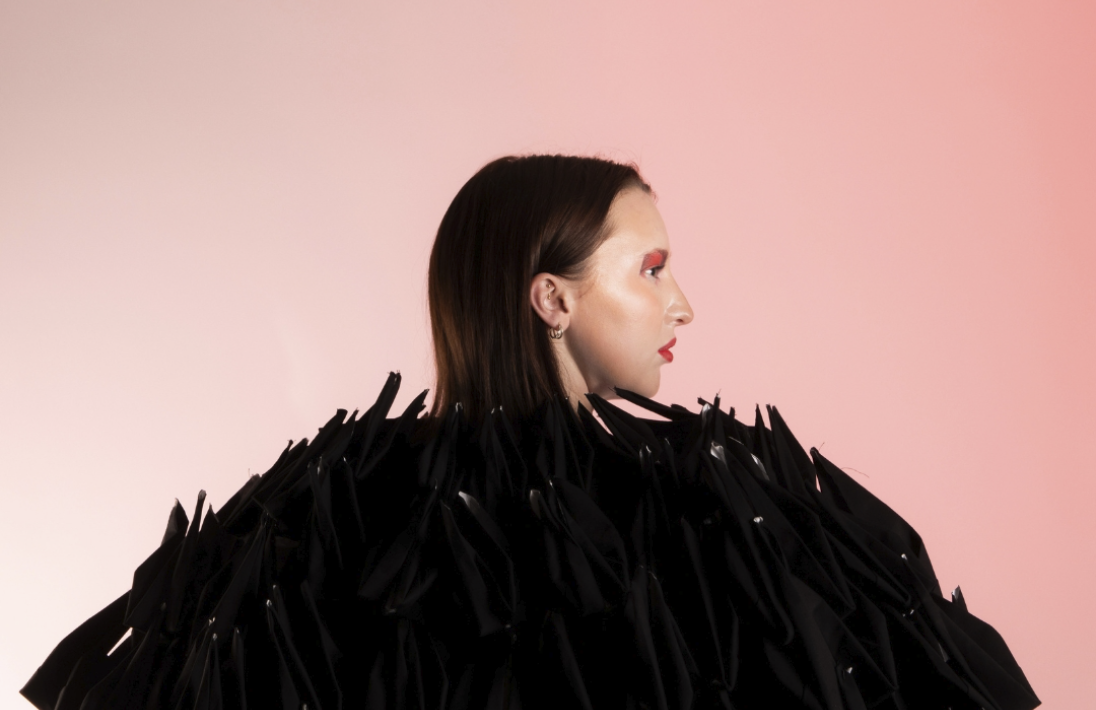Who doesn’t love origami? Long story short, I’m obsessed with it, and earlier this year, I had the pleasure of getting to know origami-lover and senior fashion designer Asia Redhead. Over the past few quarters, I’ve cut many interfacing-bound squares and folded countless fabric cranes for her collection, The Paper Crane’s Special Wish. Once the post-jury madness had settled, we sat down at Eckburg Hall, the place where it all started, to discuss the highs, lows, and everything in between.
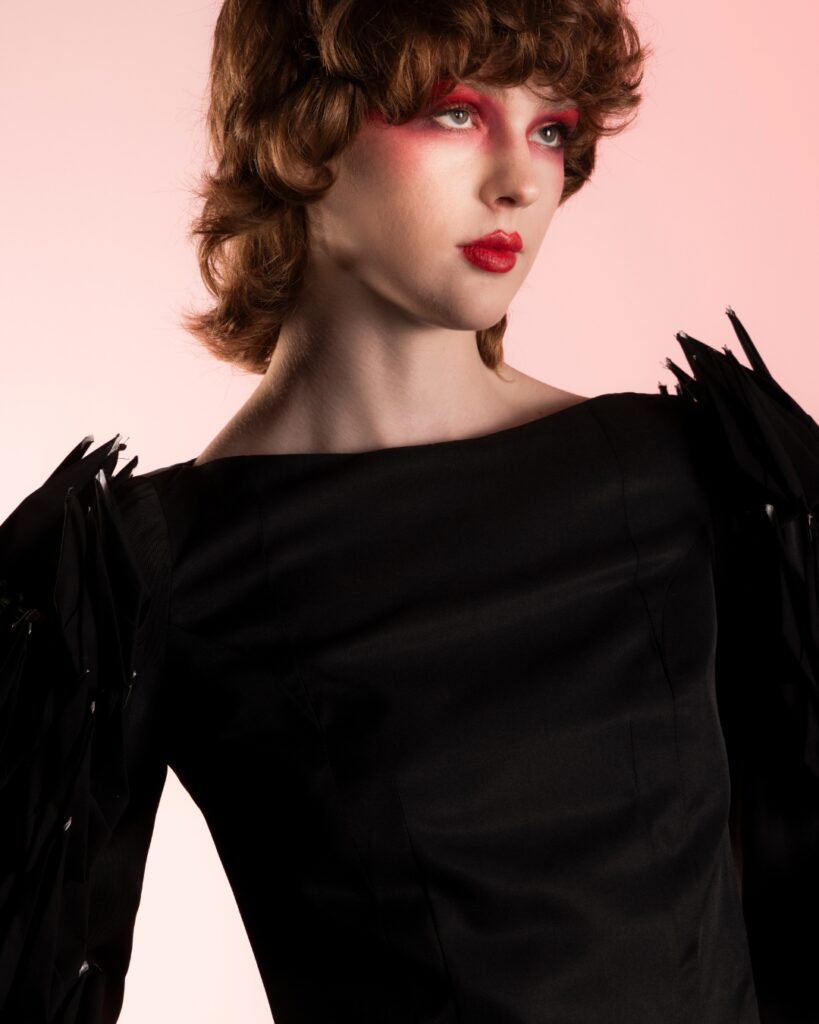
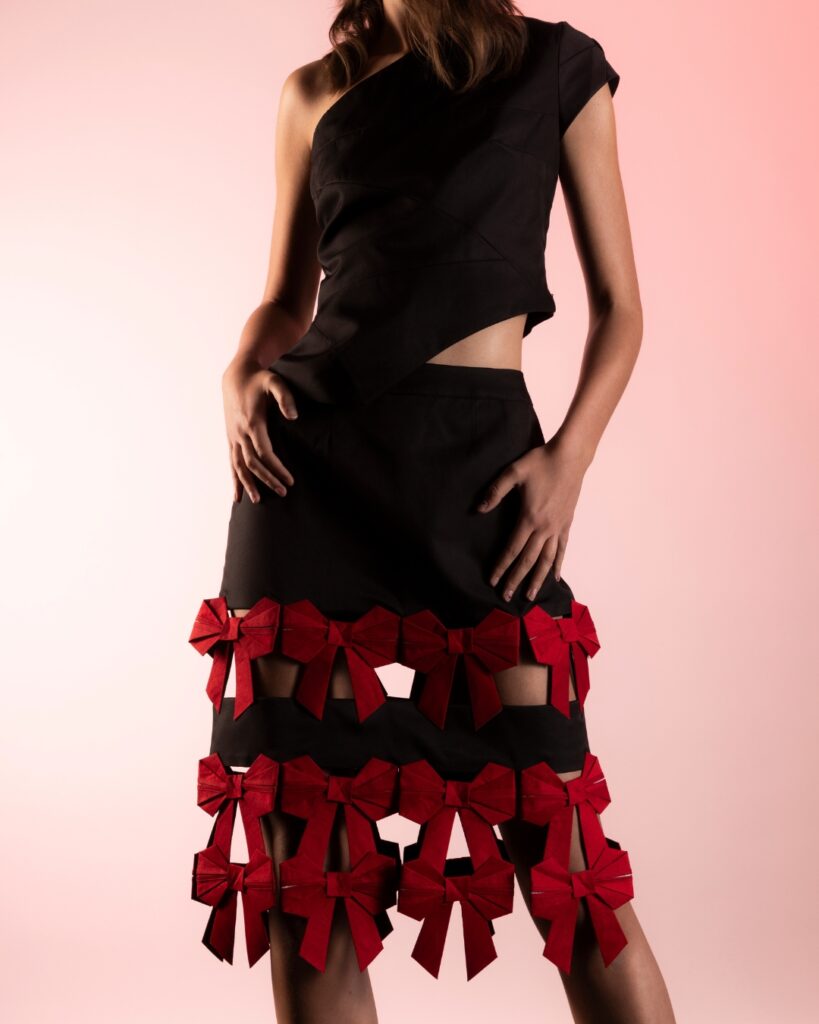
Miia Popovics: So, first, I wanted to get into the concept itself because, obviously, I’m really familiar with it. But, for those who aren’t, how would you best summarize your concept?
Asia Redhead: So my concept and my collection is titled The Paper Crane’s Special Wish, and it’s inspired by the saying that if you fold 1000 paper cranes, you’ll be granted a special wish. I was inspired by all kinds of origami. I was really inspired by the simplicity and intricacy that origami has, so I drew a lot from that in my inspiration in my design process.
Popovics: I love how you say simplicity, and then I look at your (ideation) books, and they’re the most intricate things I’ve ever seen. I do understand what you’re saying…that it really is about the folding itself…but was your focus always origami, or were there other concepts?
Redhead: Yeah, so over the summer before senior (year), we had to make three different concept books, and each of them was supposed to be really in-depth. You do all this research and kind of start ideating for three completely different concepts. So, on the first day of class, we all present our three concepts and we pick one. And so for me, the origami one was the one that really stood out the most to my class. I realized that that one had the most visual influence I could draw from. In terms of ideation and design development, I did a lot of collaging at the start, just put the shapes on top of a croquis, then from there I would sketch over it, and that kind of became my initial process. I started making 3D shapes and then draping with that on the form. And that was a lot of fun. I really enjoyed that part of the process.
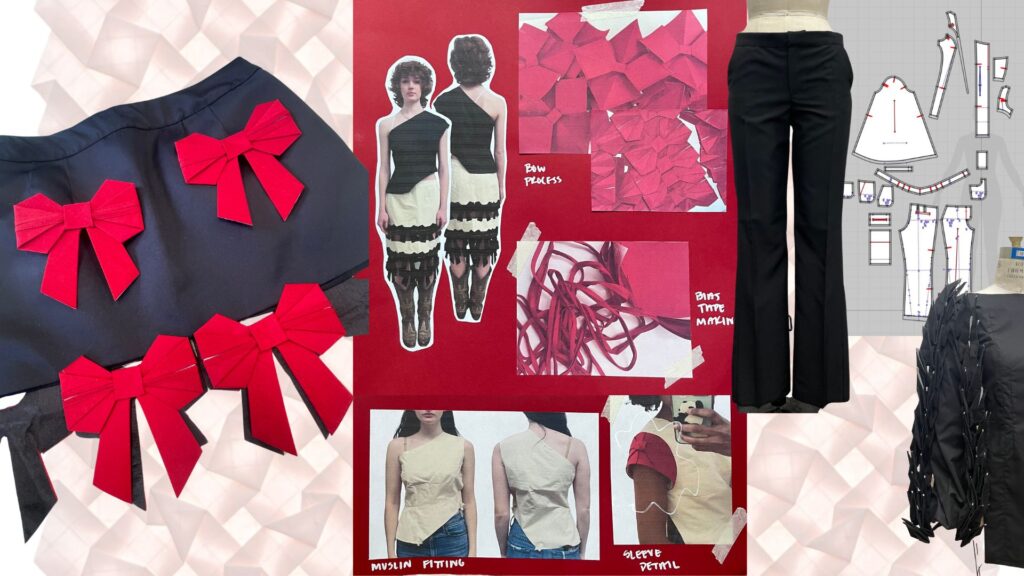
Popovics: Were most of your concepts kind of about 3D elements and shape, or was origami a thing of its own?
Redhead: Actually, no, my other concept had to do with liminal space and uncanny valley. It was very conceptual, and the other one was about autism and my experience with autism, and I drew inspiration from art made by autistic people. So all of my concepts were really different. The other ones were a little more conceptual. There’s a lot of history with origami. I found that with this one, a lot of people can connect with it because origami is something that a lot of people do in their childhood. It’s something that a lot of people do to kind of pass time. It’s one of those fun little things, and I loved the idea of having a concept that was a little bit light-hearted. Because you can really go in this direction of concepts that are really personal, which I love, but I knew from the start that I wanted to have something that was kind of fun and cute and light-hearted. So this one really lent itself to that.
Popovics: I love how you’re talking about the relationship and the story of origami. So, was that a big part of your childhood, or is this something that’s kind of come to you now?
Redhead: Yeah, it actually was a huge part of my childhood as well. I remember when I was little and my family would go on vacation. You know how hotel rooms always have a little pad of paper and a pen? So, me and my dad would take that paper, and we would always make little drawings, little sketches, or things folded up into origami. And as a kid, I was always crafty. I was always stealing paper from the printer and just making things out of it, and my parents would yell at me. But there’s that personal element with it, and I really love that about it as well.
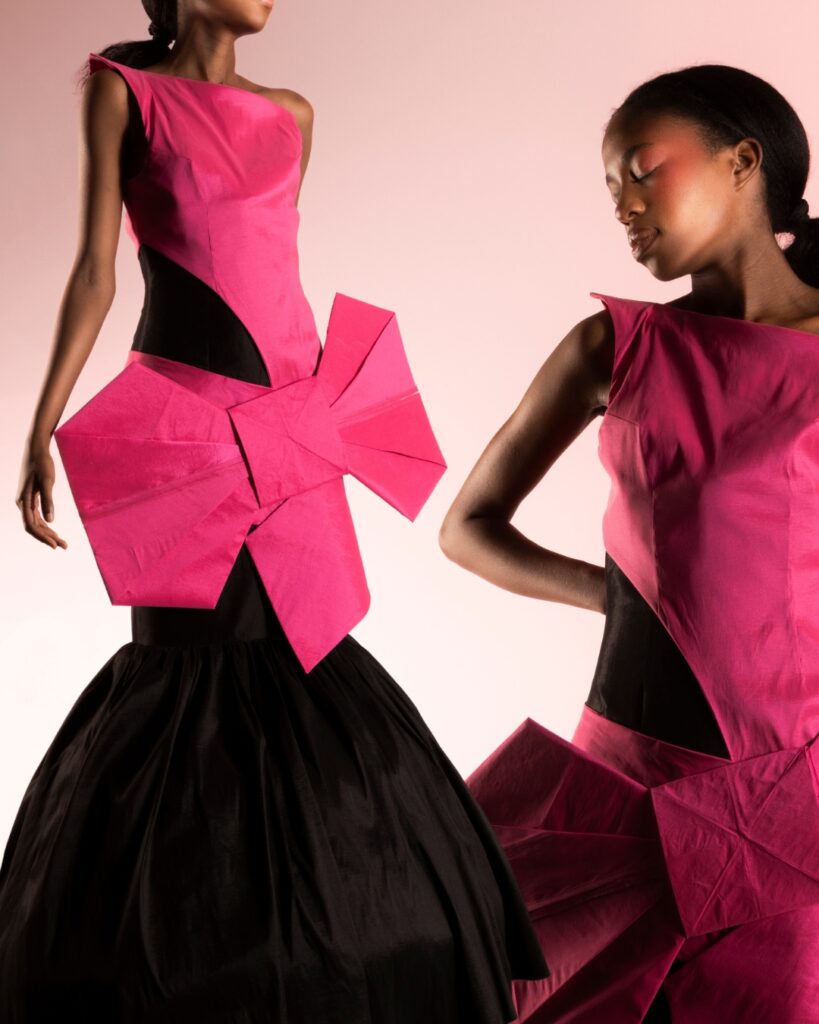
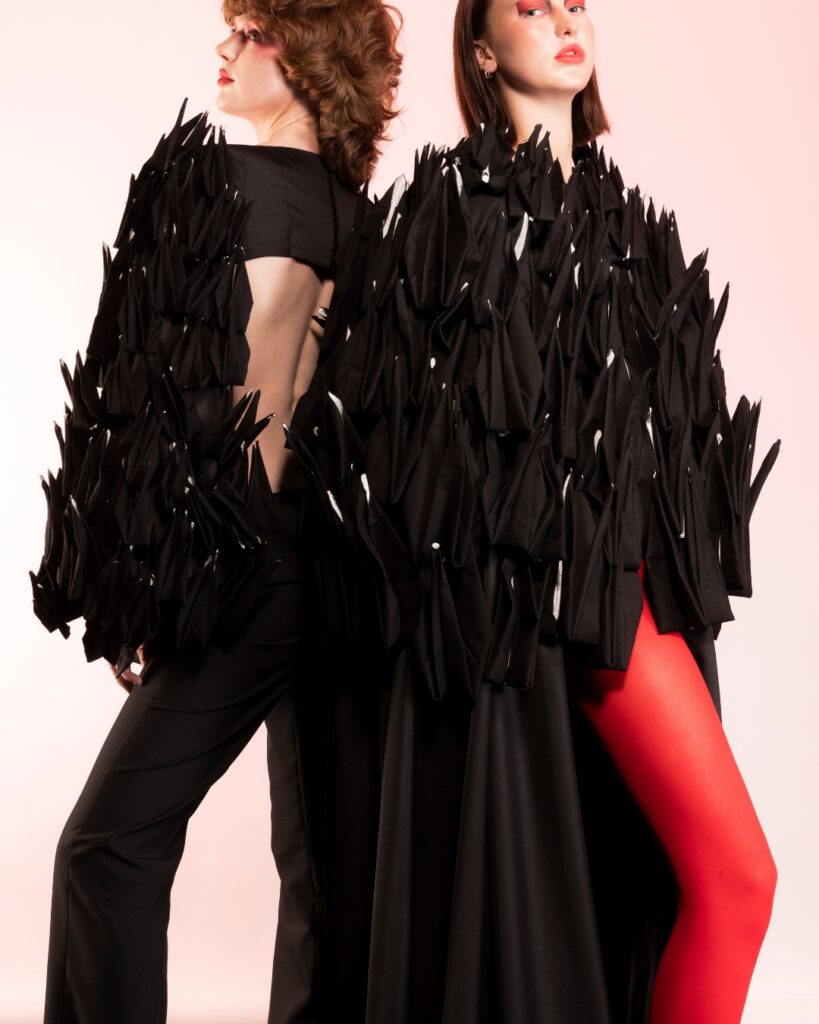
Popovics: That’s so sweet. I really connect with the hotel paper thing because I used to write notes for staff or write stories on it. But I want to talk more about the folding process itself because I know that’s a really integral part of your concept. Was that something that became natural to you towards the end? Or was that kind of a constant adjustment?
Redhead: I would say yes. Because when I was first researching, I was really just folding all different types of origami because there’s so many things you can do, and there’s so many levels of intricacy with it. For example, there’s this one type that’s called tessellations. It’s flat, and you score the paper into a bunch of different triangles, and then you do a series of many folds, and it all overlaps to create this intricate kind of flat, folded piece of paper. So I would take that, and then I would drape with it. Then, when I decided on my motifs being the paper crane and the origami bows, I kind of developed a system because I knew I was gonna have to fold a bunch of paper cranes, and I knew I was gonna need help with that. So when I would have my little folding sessions, I ended up kind of doing the system where I would fold 10 of one step, and then I would move on to the next step and with all 10 and kind of so by the end of it I feel like I could fold a paper crane in my sleep and I kind of love that.
Popovics: That’s so efficient. Honestly, I think the way I was doing it was terrible. In my head, I was like, “I have to finish this one before I can move on to the others.” But, I do want to move on to your color story because it’s really present throughout all components of your presentation, like this (concept) book and your incredible 3D box that folds out. Obviously red is really important, red and black, but I know you used to have pink.
Redhead: From the very beginning, I knew I was going to incorporate red because the pages of my research book are all red. And I knew I was going to incorporate black because I love black. I feel like the usage of those two colors really ties in because red is the ultimate representation of boldness, and black is the ultimate representation of silhouette, and I think those two words really encompass my collection. I did have other colors incorporated at one point, but I think sometimes during the process that things happen. You get a fabric and the color isn’t exactly how you pictured, and you have to pivot and that’s kind of what happened.
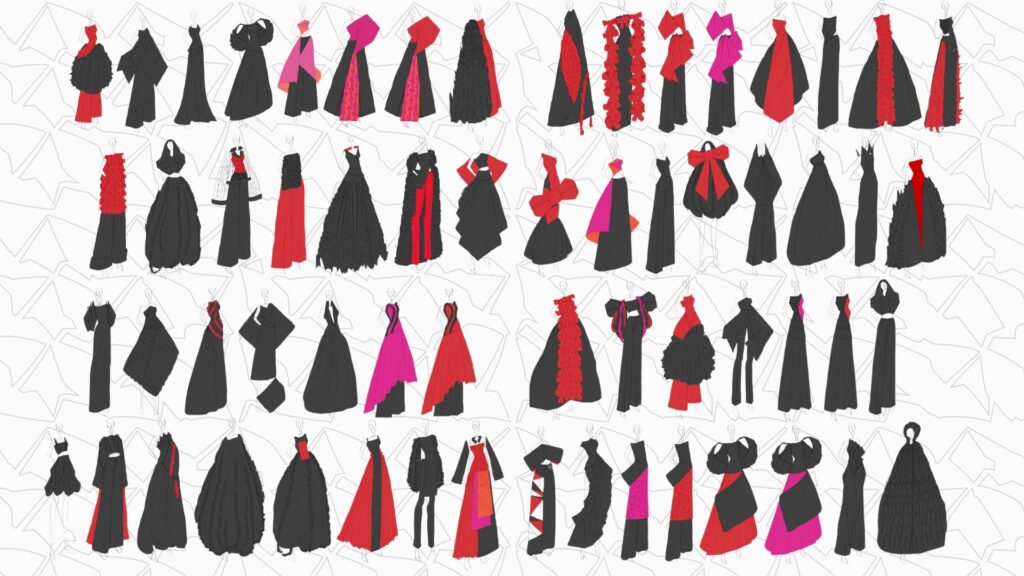
Popovics: I know a lot of other seniors had to adapt because the fabric samples they ordered were completely incorrect. So, how did you adapt in situations where it’s kind of high pressure?
Redhead: I really had to learn how to listen to my gut, because you can sketch something out, and then you start making it and it’s just not working with a time crunch. What ends up happening is you have to pinpoint those situations really quickly and then pivot quickly. The look with the bow skirt, I originally had a different top to go with that. And when I made the muslin, that particular top ended up being so freestyle, and then it ended up not being quite what I wanted. So then when I got to making the final garment, I had to make a whole new muslin, and it’s actually the top I’m wearing.
Popovics: That was originally the one that had the peplum, right? Yes, I remember that. This one is so beautiful.
Redhead: This top is the simplest piece in my collection, and I think that’s what made it so hard because I really like the idea of simplicity, and I think doing it right and not just adding things for the sake of adding was something that I was really kind of wrestling with. So yeah, I honestly just listened to my gut, and I also just had fun with it. This top includes a little cap sleeve. It’s a half-folded origami bow sandwiched into the sleeve. And that kind of came about just because of pure fun and experimentation. So yeah, I think listening to my gut is something that I really had to learn.
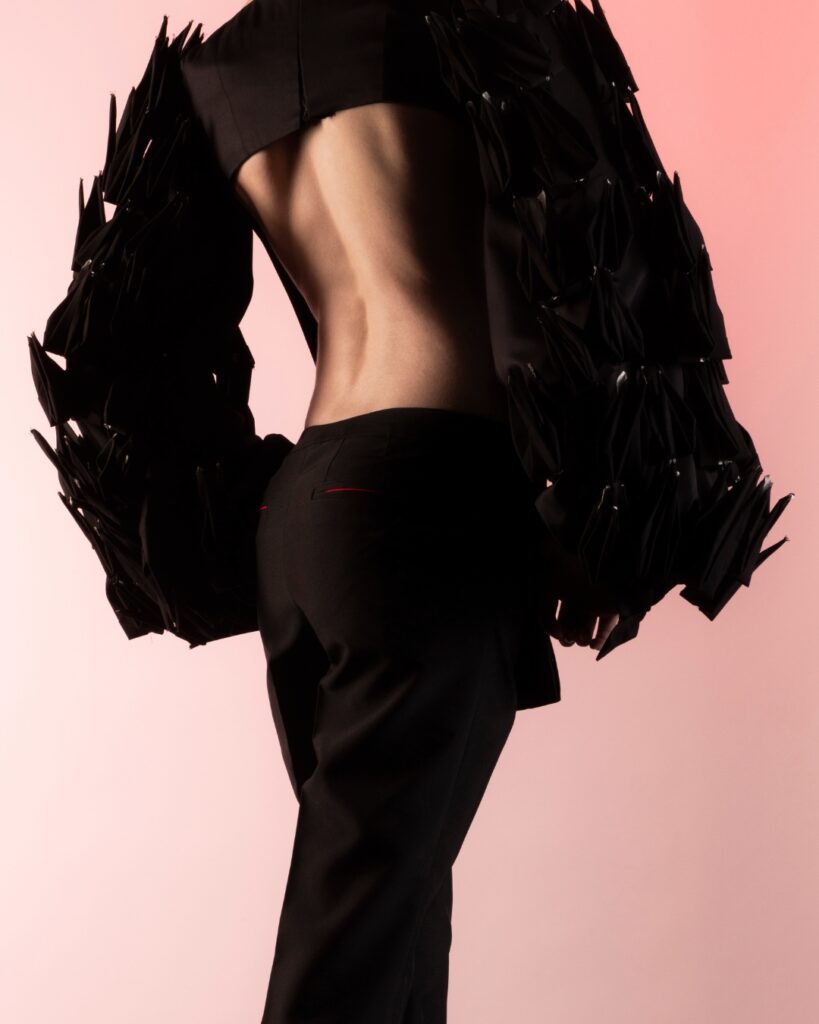

Popovics: I mean, again, you say simple, but from my standpoint, I can tell the amount of effort, work, and tailoring you’ve put into this. It looks fully finished, and it fits so well. Going off how much time you put into this, I know it’s really no joke, senior collections are hard. I was wondering if there was anything specifically like a food, or a song, or a movie, or a drink that really got you through it?
Redhead: Oh, wow. I think there’s a lot.
Popovics: It’s okay, name them all!
Redhead: Okay, I’ll name them all. One thing I really enjoy is listening to music and listening to podcasts. Because when you’re at the studio for X amount of hours, I need something happening in my brain. I need stimulation in my brain. So I’ve listened to a lot of podcasts and listened to a lot of music, and I think that really got me through it. Also, Fancy Parker’s runs at 3am really got me through it. Also, even just working in the studio amongst my friends and my classmates that were also working towards the same goal of their senior collection. I think that is the biggest thing. It’s one thing to do this alone, but it’s another thing to be with other people who you can relate to and you can lean on because everyone ends up leaning on each other. And I think that’s a really beautiful thing. I think that’s something that I’ll remember for the rest of my life.
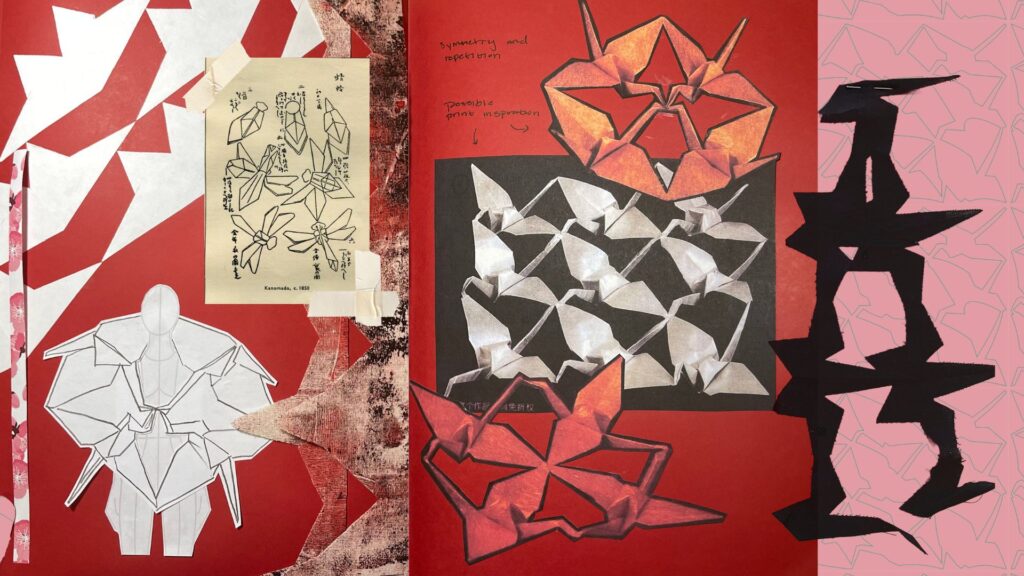
Popovics: I really love that. Every time I’d come into various different senior classrooms, everyone’s collections would be so different, so versatile. But someone would be like, “I need help. I don’t know how to do this. I’m so stressed out.” And then someone else would be like, “Oh, I’ll show you this right now. Don’t freak out about it.” That collaborative spirit was really sweet. And I do agree. I feel like that’s something that forces me to be productive as well. That’s such a good memory to take away from this. I was wondering if there’s anything else that you think is really going to stick with you for the rest of your time?
Redhead: Oh my god. Where do I start? I think the biggest thing that I’ll take away is one word, that is: support and support. Like I said, from not only my peers, but from my professors and from my mentor. I think that I’ve learned a lot about asking for help.
Popovics: I feel like I cannot conclude this interview without talking about your mentor, Bruce Pask. I was wondering; he’s everywhere all the time, he’s not based in Savannah. He’s in New York, he’s here, he’s in Italy. How does your creative dynamic work, but also how does your communication function when you don’t necessarily have a mentor here all the time, like on ground?
Redhead: So we had quite a few meetings in person, and at each point, it was kind of a different step in the process. At our first meeting, I showed him all my boards and my research book and told him about my idea. Then I kind of got into showing him my muslins, and what I really loved was getting a new perspective from somebody who is not in it all the time. Yes, I have my professor (Andrew Fionda), and he gives me great feedback all the time, but he’s in it, and he’s here every day. So I loved hearing from somebody who has an outside perspective, and he gave me a lot of valuable points about stuff that I wasn’t really thinking about, especially my editorial shoot in my film. I kind of had rough ideas for that, but he helped me refine that and really make it its best. So I really appreciate all of that. Even during critiques, something that I really, really appreciated, and I think something that will stick with me is that it always felt like he was somebody who was on my side during critique. Just him being there, he would insert his points to all the people in critique, and it was nice to have someone to lean on who got to hear my concept, my perspective, a little bit more in-depth and could kind of speak to them about that from his perspective. So that was something that was really valuable, and I really appreciate it.
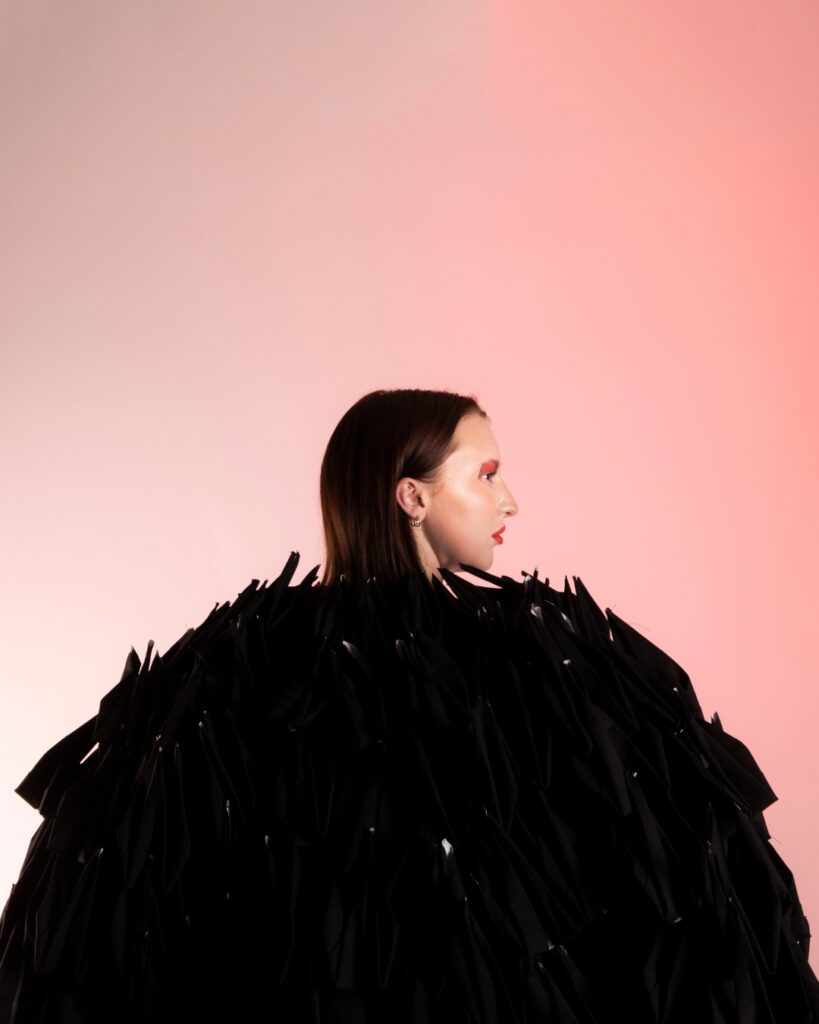
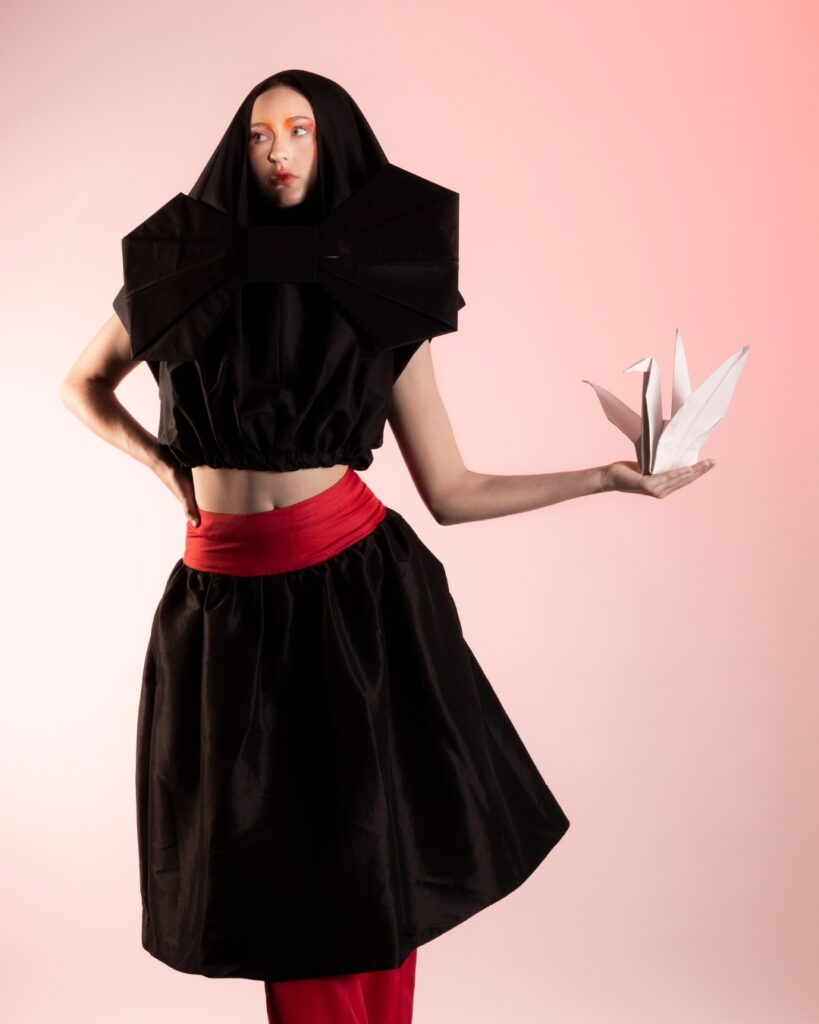
Popovics: That’s so cool. I have to talk about your editorial and your film because I haven’t seen it yet, but I do have a lot of questions. Do you think because you’re so involved in the design process, that when it comes to the editorial and the film part of it, it’s a little bit harder to shift? Or, do you think it immediately was like, “Oh, well, I know what I want to do.”
Redhead: Yes, I would say absolutely. It was harder to shift, because I really enjoy designing the clothes, making the clothes, and just kind of doing that side of it. I’ve always struggled with being a director of it all, organizing shoots, and getting a team together. That’s always kind of been a struggle to me, so it was definitely a really daunting task to do that alongside making all the garments. I ended up working with some incredible people. My photographer, my videographer, the assistants, and everybody who was there to help me really made it easier for me. I could tell them my vision, and then they could collaborate with me, and together, we made a product that is beautiful and that I’m really happy with. I’m happy that I found people that I really loved working with to help me with that.
Popovics: I do also want to mention the Fashion Scholarship Fund. I noticed that as you were finishing that up, it was at a part of senior collection where you had to be working on that (the collection) a lot. So, juggling these two really important things must have been really difficult. But, I wanted to know if you feel like the Fashion Scholarship Fund helped your collection in a way.
Redhead: Yeah, absolutely. So, during fall quarter of senior year, when I was finishing up my submission for FSF. I was kind of doing both at once, and I really wanted to try my hardest with the FSF submission. So, I was so happy and grateful when I won. I think that it has helped me not just with my collection but with everything because I was provided with so many people that I can reach out to and so much support, aside from the monetary aspect of it. I was given the opportunity to fly to New York for the gala, and that was during spring quarter when I was finishing up making my collection. So that was definitely a stressful time, but it was so much fun, and I would do it all again. Bruce also was there at the gala to support, so that was really fun. I mean, I just felt support from every angle, and I think that it also gives me that validation and that boost to finish my collection, and you know, it really gave me that push to get me through emotionally, so I’m really grateful to have had that opportunity.
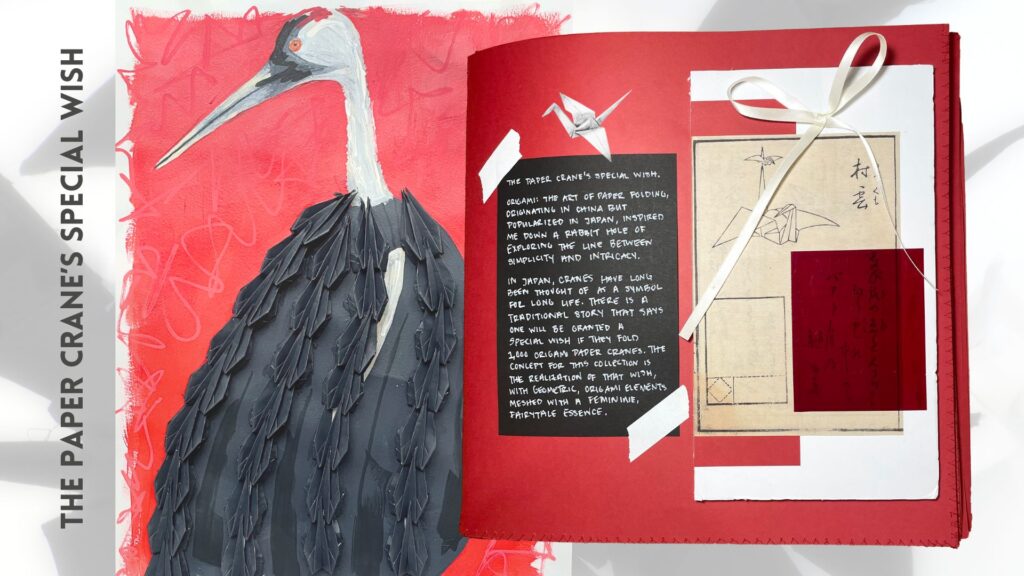
Popovics: I do want to talk about your time at SCAD, because it’s coming to an end, and I want to know if there’s something that you’ll miss the most here going out into the world.
Redhead: I think there’s a lot that I’m gonna miss. First of all, I’m going to miss Andrew, my senior professor, because I feel like he’s played the biggest role in shaping me into the designer that I am today, and I think that I’ll miss him dearly. Also, just being in an environment that encourages me and kind of forces me to be creative every day and challenges me, I think I’ll miss because I’ve always been somebody that strives in an academic setting and being around other people who are working towards the same thing as me, so I think that’s definitely something that I’m gonna miss a lot.
Popovics: Do you think there’s any more school in your future? Or are you solely focused on career goals now?
Redhead: I would say, at this point, I’m solely focused on my career goals. I mean, it would be awesome to do more school, but I think that my priority right now is just finding a job. I really crave that kind of experience, making things for the real world in the context of the real world. Because I do enjoy my design style, I can be very conceptual, but I think at my core, I really love making garments that people want to buy and people want to wear. So, I think I really am craving that experience. In the future, maybe I go back to school and branch out; maybe I do something a little different.
Popovics: Okay, so, you spent four years here, a lot of things can happen over that time. We touched on it a little bit earlier, but I really want to know what a core memory is from your time at SCAD.
Redhead: I would say my core memory is jury critique and jury show. Jury show was the first time that I got to see all my looks together walking on models, and you can ask all my friends that I was sitting next to, but as soon as I saw my garments walk across, I burst into tears. I think my jaw was to the floor, because I froze and then the tears just started pouring out. It was just like a full circle moment because when you’re working on something for so long, you are hyper-focused and you’re looking at it from such a close lens. Seeing it on a stage with the lights zoomed out, I was like “whoa, oh my god, I did that.” That was the first moment where I actually processed all of it. And yeah, I think that’s definitely my biggest core memory.
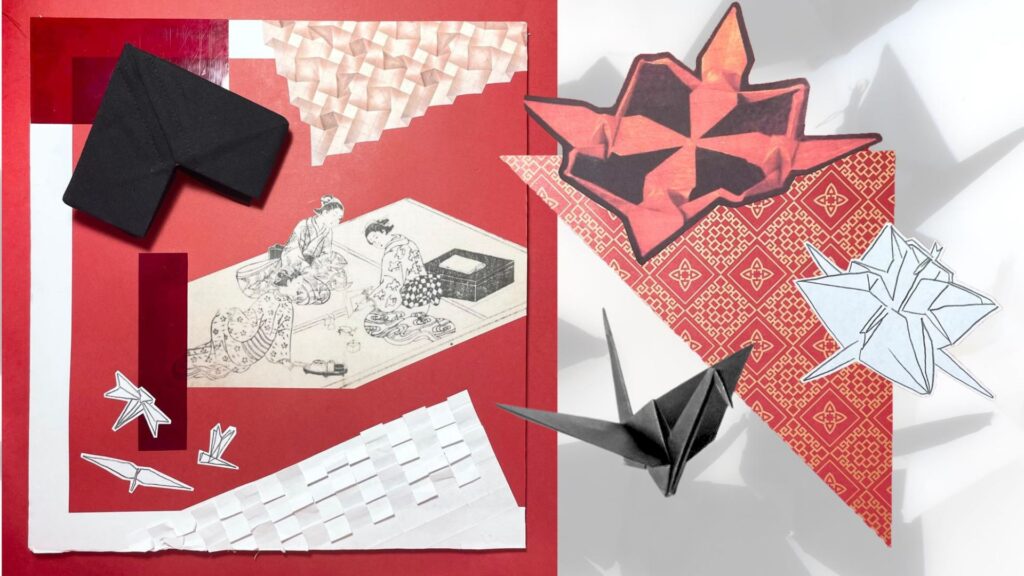
Popovics: That’s so sweet. I just wanted to say thank you for involving me in this process. Getting to know all of these seniors and how much work everyone, especially you, put into their collection was just so special to me, and I feel like it really made me realize how much I appreciate each and every single designer out there. So yeah, I really just want to say thank you for involving me in this. I can’t wait to see where you go.
Redhead: No, thank you. Let me just say that my collection would not be what it is without you because if I didn’t have help with folding those cranes, I would have been in trouble.
Popovics: Wait, what was the final crane count? I need to know. Do you know?
Redhead: I have no idea, but I’m going to say 1000.
Popovics: You heard it here folks, 1000 cranes, on the record.
Interview by Miia Popovics
Designer, Asia Redhead
Photography by Sophia Lee
Photo Assists by Sam Bell and Wyatt Junnila
Makeup by Ari Young Sang and Nadya Lopez
Talent by Isabelle Leaf, Faith Mclawhorn , Jade Imani, Sidney Shaffer, and Chloe Hill

